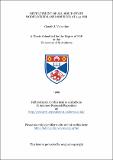Development of all-solid-state modelocked laser sources at 1.55 μM
Abstract
This thesis concerns the generation of tunable ultrashort pulses near the 1.55 mum telecommunications window. Two principal laser systems are considered: i) the NaCl:OH colour-centre laser, which employs the technique of synchronously-pumped modelocking to generate tunable picosecond pulses and ii) the self-modelocked Cr4:YAG laser to generate femtosecond pulses tunable from 1.5-1.56 mum. Details are given for an all-solid-state cw and cw-modelocked pump source for Cr4:YAG and colour-centre lasers based on Nd:YAG. Fibre-coupled AlGaAs laser diodes are employed as the solid-state pump source to this laser. When operated cw, up to 8.5 W of linearly polarised output power in a TEM00 beam is obtained. A compact cw actively-modelocked Nd:YAG laser is described having a pulse repetition rate of 194 MHz. Pulse durations down to 34 ps and output powers up to 6.0 W are obtained from this system. An 82 MHz Nd:YVO4 laser is also detailed producing pulsewidths down to 75 ps and average output powers up to 3.5 W. The intrinsic noise source associated with the synchronous modelocking technique is discussed and a simple passive stabilisation scheme, coherent-photon-seeding (CPS), is described and applied to the synchronously-modelocked NaCl:OH laser. Results of a simulation of this laser are reported and a comparison is made with the practical observations of the stabilised laser. For the first time, theoretical and experimental evidence for the presence of high frequency pulse jitter in synchronously-pumped- modelocked (SPML) lasers is presented and the coherent photon seeding technique is shown to eliminate this noise. Details are also given for the construction of a compact, all-solid-state, femtosecond Cr4+:YAG laser. A design prescription for laser resonators having a high propensity for self-modelocking is presented and an unconventional 3-mirror resonator is adopted for optimised self-modelocked operation. Using this design, modelocked output powers up to 300 mW with 120 fs pulses from a compact, regeneratively initiated laser having a pulse repetition rate of 320 MHz is reported for 4.7W incident pump power. Self- modelocking is demonstrated for pump powers down to ~1W with this cavity design. A compact cavity design for self-modelocking is also assessed, with a footprint of just 20 X 25 cm, which places a prism in each cavity arm. 470 fs pulses at 220 mW average output power are reported.
Type
Thesis, PhD Doctor of Philosophy
Collections
Items in the St Andrews Research Repository are protected by copyright, with all rights reserved, unless otherwise indicated.

